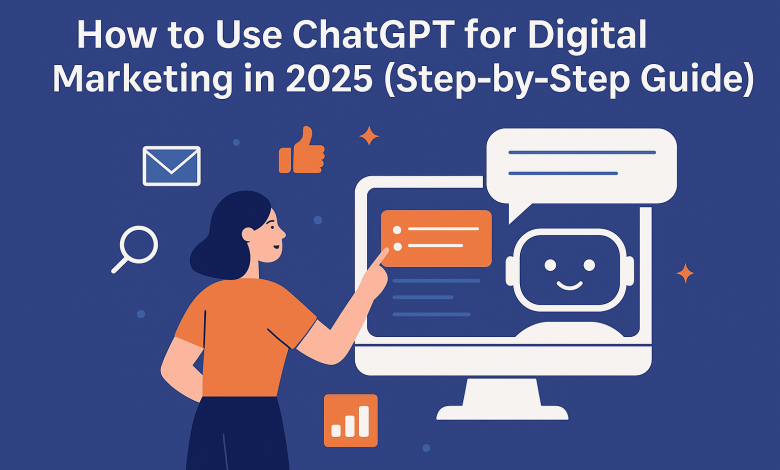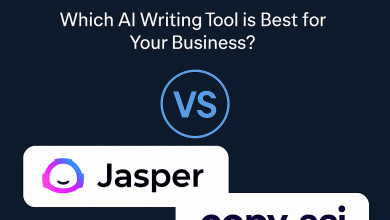How to Use ChatGPT for Digital Marketing in 2025 (Step-by-Step Guide)

Digital marketing has always been about one thing: staying ahead of the curve. From the rise of SEO in the 2000s to the explosion of social media in the 2010s, businesses that adapted quickly gained a competitive edge. Now, in 2025, we’re in the middle of another revolution—AI-powered marketing.
At the center of this shift is ChatGPT, a tool that has gone far beyond being “just a chatbot.” Today, ChatGPT acts as a full-stack marketing assistant. It can help you brainstorm content ideas, write ad copy, draft blog posts, create email sequences, generate SEO strategies, and even engage with customers—all while saving you time and money.
So, how exactly can you use ChatGPT to level up your marketing strategy in 2025? Let’s dive in.
Why Marketers Are Turning to ChatGPT
Before we get into the “how,” let’s look at the “why.”
-
Cost-effective: Instead of hiring multiple freelancers for content, copy, or emails, you can use ChatGPT for initial drafts and ideas.
-
Time-saving: What would normally take hours (like writing a blog post outline or ad campaign) now takes minutes.
-
Scalable: Whether you’re running one campaign or ten, ChatGPT can handle the load.
-
Versatile: It can create marketing material across platforms—Google, Facebook, LinkedIn, TikTok, email, blogs, and more.
Think of ChatGPT as your marketing Swiss Army knife.
5 Ways to Use ChatGPT for Digital Marketing in 2025
1. Writing Ads That Convert
Ad copy is one of the toughest parts of marketing. The text has to be short, catchy, and persuasive. ChatGPT can generate multiple variations for you to test.
Example Prompt:
“Write 5 variations of a Facebook ad headline for an eco-friendly water bottle brand. Keep the tone casual and persuasive.”
Result: You’ll get a mix of creative headlines you can A/B test in real campaigns.
2. Social Media Content Creation
Managing social media can feel like a full-time job. With ChatGPT, you can batch-create content calendars, captions, and even hashtags.
Example Prompt:
“Create a 7-day Instagram content plan for a small coffee shop. Include captions, hashtags, and call-to-actions.”
This way, you’re not just posting randomly—you’re following a structured strategy.
3. Email Marketing That Gets Opened
Email still delivers one of the highest ROIs in marketing, but crafting subject lines and email sequences can be time-consuming. ChatGPT can generate catchy subject lines and write emails tailored to your audience.
Example Prompt:
“Write a 3-email welcome sequence for a new subscriber who joined an online fitness newsletter. Keep it friendly and motivational.”
You can then tweak the emails to match your brand voice.
4. SEO and Blogging Made Easy
Search engine traffic remains crucial in 2025. ChatGPT can help with keyword brainstorming, blog outlines, and even drafting sections of an article.
Example Prompt:
“Create an SEO blog outline for the keyword: ‘best productivity apps for remote teams in 2025.’ Include H2 and H3 subheadings.”
This saves you hours of planning and ensures your blog is structured for SEO.
5. Customer Service and Chatbots
With the right setup, ChatGPT can serve as a customer service assistant. It can answer FAQs, provide recommendations, or even help customers troubleshoot basic issues.
Example Prompt:
“Write a polite, professional response for a customer asking for a refund on a late delivery order.”
By integrating ChatGPT into your website or support system, you can offer 24/7 customer assistance.
Best Practices for Using ChatGPT in Marketing
Using ChatGPT effectively isn’t just about prompts—it’s about strategy.
-
Be specific with prompts: The clearer your instructions, the better the output.
-
Edit everything: AI provides drafts; humans provide polish. Always add your brand’s personality.
-
Stay ethical: Don’t use AI to mislead customers or spam content.
-
Combine AI with data: Use your analytics to refine AI-generated ideas.
-
Test, test, test: Use A/B testing to see what actually works with your audience.
ChatGPT vs Traditional Marketing Tools
| Task | ChatGPT Strength | Traditional Tools Strength |
|---|---|---|
| Ad Copy | Fast variations | Deeper analytics |
| Social Media | Content ideas | Scheduling + analytics |
| Email Marketing | Drafting emails | Automation & segmentation |
| SEO & Blogging | Outlines, drafts | Keyword tracking |
| Customer Service | Instant replies | Human empathy |
The best results often come from combining both. For example, use ChatGPT to create email drafts, then run them through your email automation software for targeting and tracking.
FAQs
1. Can ChatGPT replace my marketing team?
No. It’s a powerful assistant, but you still need humans for creativity, strategy, and brand voice.
2. Is ChatGPT good for SEO?
Yes, it can help generate blog outlines and keyword ideas, but you should still rely on SEO tools for keyword tracking and performance analysis.
3. How do I make sure my content doesn’t sound “AI-generated”?
Edit the drafts, add personal stories, brand tone, and unique insights. That’s what makes it authentic.
4. Can ChatGPT work with other tools?
Absolutely. Many businesses combine ChatGPT with tools like HubSpot, Hootsuite, or SurferSEO for better results.
Final Thoughts
In 2025, ChatGPT isn’t just a novelty—it’s a necessity for digital marketers. Whether you’re running ads, managing social media, writing blogs, or sending emails, this tool can cut your workload in half while improving results.
But remember: the best marketers use ChatGPT as a partner, not a replacement. AI gives you the speed and efficiency, but your human touch provides the authenticity and strategy.
Start by testing ChatGPT in one area of your marketing (like social media or email). Once you see the results, expand its role. Before long, you’ll wonder how you ever ran your campaigns without it.

